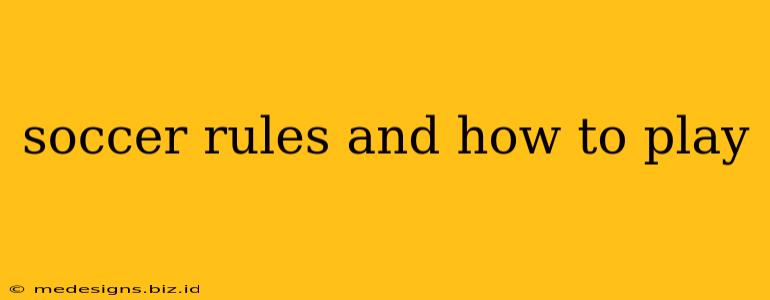Soccer, also known as football in many parts of the world, is a globally beloved sport. Millions play and watch it every year, but understanding the rules can sometimes be tricky for newcomers. This comprehensive guide breaks down the fundamental rules and how to play soccer effectively, whether you're a beginner or looking to brush up on your knowledge.
The Basic Objective: Scoring Goals
The primary goal in soccer is simple: score more goals than your opponent. You achieve this by getting the ball into the opposing team's goal. This seemingly straightforward objective involves a complex interplay of skill, strategy, and teamwork.
Key Rules and Gameplay:
- The Field: A rectangular field with goalposts at each end. The size of the field varies slightly depending on the level of play (youth, professional, etc.).
- The Teams: Two teams of 11 players each compete. One player on each team is the goalkeeper, who is allowed to use their hands within their penalty area.
- Gameplay: The game is divided into two 45-minute halves with a short break (halftime) in between. The referee controls the game and enforces the rules.
- Starting the Game: The game begins with a kickoff, where one team places the ball in the center of the field and kicks it to start play.
- Moving the Ball: Players can move the ball by kicking it, heading it, or using any part of their body except their hands (except for the goalkeeper in their penalty area).
- Fouls: Numerous actions constitute fouls, including tripping an opponent, pushing, holding, or handling the ball (outside of the goalkeeper's allowed area). Fouls result in a free kick for the opposing team.
- Free Kicks: A free kick is awarded when a foul is committed. The opposing team tries to score a goal directly from the free kick. A wall of defending players is often used to block the shot.
- Penalty Kicks: A penalty kick is awarded if a foul occurs inside the penalty area, often leading to a direct shot on goal.
- Throw-Ins: When the ball goes out of bounds over the sideline, a throw-in is awarded to the opposing team. The throw must be taken from over the head with both hands.
- Goal Kicks: If the attacking team puts the ball out of bounds over the end line, the defending team gets a goal kick from their own penalty area.
- Corner Kicks: If the defending team puts the ball out of bounds over the end line, the attacking team gets a corner kick from the corner of the field.
- Offside: A player is in an offside position if they are closer to the opponent's goal line than both the ball and the second-to-last defender when the ball is played to them. This is a complex rule and often misunderstood, but essentially, a player can't gain an advantage by being in an offside position.
Key Skills for Playing Soccer:
Becoming a proficient soccer player requires mastering several key skills:
- Dribbling: Controlling the ball while moving, using your feet to maneuver around opponents.
- Passing: Accurately distributing the ball to teammates.
- Shooting: Striking the ball powerfully and accurately towards the goal.
- Heading: Using your head to control and direct the ball.
- Tackling: Winning the ball from an opponent (without committing a foul).
- Goalkeeping: Preventing the opposing team from scoring.
Strategy and Teamwork:
Soccer is not just about individual skill; it's heavily reliant on teamwork and strategy. Teams develop formations and playing styles to maximize their offensive and defensive capabilities. Communication and coordination are essential for success.
Learning and Improving:
Whether you're just starting or looking to improve your skills, practicing regularly is key. Joining a local soccer club or team provides excellent opportunities to learn from coaches and teammates. Watching professional games can also help you understand different strategies and techniques.
This comprehensive guide provides a foundation for understanding soccer rules and gameplay. While nuances exist, mastering these basics will enhance your enjoyment and understanding of this incredibly popular sport. Get out there and start playing!
